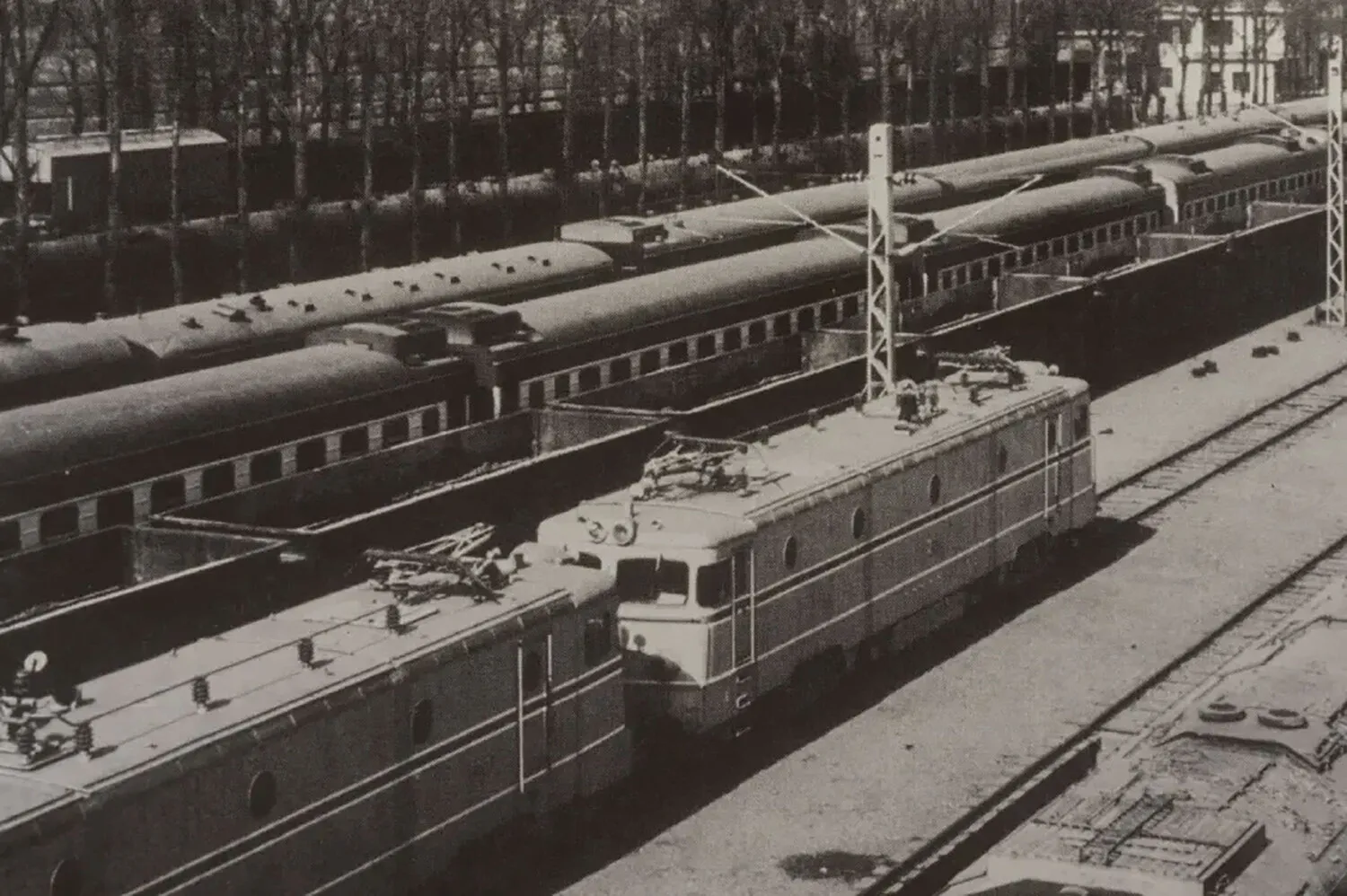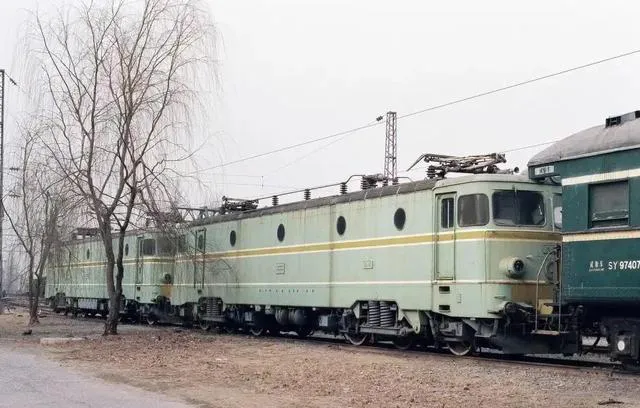1971
The Romanian National Railways Agency identifies the 060 EA/EA1
electric locomotives and 060 DA diesel locomotives as potential
resources for repaying loans. In a strategic move, China agrees to
import a consignment of 060 DA locomotives to serve the Shanghai
Railway Bureau and Guangzhou Railway Bureau. Concurrently, a
limited order for 060 EA1 electric locomotives is placed for the
Xi'an Railway Bureau to assess their performance against similar
locomotives imported from France, informing future procurement
decisions.
By late 1971 and early 1972, the China Machinery Import and Export Corporation, alongside the Romanian Craiova Electric Locomotive Equipment Company, formalizes two agreements for locomotives. The first agreement entails the acquisition of 50 internal combustion locomotives, tailored for China Railways and designated as ND2 locomotives. The second agreement outlines the supply of two electric locomotives, derived from the 060 EA1 model, which are recognized as 6G1 electric locomotives. The nomenclature includes "6" for the six axes, "G" for silicon semiconductor rectification, and "1" indicates that it is the first legal import within its class.
The 6G1 electric locomotive is structured as a six-axle trunk freight transport unit featuring a box-type frame, supported by side walls and a bottom chassis. It incorporates a bilateral through-type inner corridor and driver's compartments located at both ends. Central to its design is the main transformer room, housing a transformer with a capacity of 6650 kVA that employs forced oil circulation for cooling. The locomotive's layout symmetrically arranges auxiliary and electrical rooms, along with a brake resistance room, at either extremity. The locomotive operates on a Co-Co axle configuration, delivering continuous power output of 5,100 kilowatts with a maximum operational speed of 120 kilometers per hour. The 6G1 model surpasses the performance of its predecessor, the 6G electric locomotive, which has a continuous power rating of 5400 kilowatts and an operating speed limit of 100 kilometers per hour.
The electrical architecture of the 6G1 electric locomotive employs silicon diode bridge rectification and high-voltage side voltage regulation, integrating 40 speed regulation levels that distribute power to six traction motors through distinct bridge rectification circuits. It features a three-phase auxiliary system designed with automatic voltage regulation to maintain operational stability during network fluctuations, significantly reducing the risk of component failure.
Resistance braking is a fundamental characteristic of the 6G1 electric locomotive, utilizing traction motors configured as excitation generators during braking events. The excitation windings of the six motors are linked in series, powered by an excitation transformer stemming from the fourth traction winding. The excitation current's intensity is modulated through a voltage regulation switch.
The locomotive's bogie is characterized by a Co-Co axle type, featuring wheels with a diameter of 1250 mm, a shaft weight of 21 tons, and a total weight of 126 tons. The design incorporates an innovative suspension system devoid of a central support, relying on double steel round springs to manage the car body's weight and enabling effective traction force transfer between the car body and the bogie. The full suspension system of the traction motor optimizes seismic performance, yielding a stable operational profile.
In December 1972, the Craiova locomotive factory in Romania successfully completes the production of the inaugural 6G1 electric locomotives, designated as 6G1-01 and 6G1-02. Following comprehensive testing on Romanian railways, these locomotives are shipped to China, arriving in Tianjin. Upon receipt, they undergo testing on the Beijing Ring Railway before commencing operational trials on the Baocheng Railway in 1973.
Test results indicate that the 6G1 locomotives meet contractual technical specifications, demonstrating reliability and stability throughout the evaluation process. The advanced traction motor technology and the ease of maintenance are noted advantages, particularly the F-class insulation, which simplifies overhauls compared to the H-class insulation used in the 6G models. The design incorporates several innovative features, including a hollow shaft transmission, full suspension, and layered brush technologies, which serve as valuable references for China's domestic traction motor development.
The locomotives exhibit substantial hauling capabilities, effectively managing 700 tons of freight on a 30‰ gradient and 1,600 tons on a 12‰ incline, making them appropriate for electrified lines with gradients below 12‰. However, the Baoji Electric Machinery Section expresses concerns regarding the 6G1’s performance, particularly on the steeper 20‰ to 30‰ gradients of the Baocheng Railway, where its traction capabilities fall short of the 6G locomotives.
Due to its performance limitations, the Baoji Electric Machinery Section assesses the deployment of the 6G1 locomotives as unsuccessful, ultimately halting further introductions of similar models. Consequently, 6G1-01 and 6G1-02 remain the only units of their type in operation. The lack of repair capabilities for these specialized locomotives leads to their sealing from 1977 onward. By 1980, both units are repurposed as transfer machines for the Beijing Railway Academy but undergo modifications to adapt to local operational requirements.
Unfortunately, the limited infrastructure and track availability on the circular railway station render the 6G1 locomotives ineffective for their intended duties. Subsequently, they are relegated to less significant tasks within pilot projects at the Iron and Steel Academy. This period of inactivity is short-lived as the lack of spare parts and an adequate maintenance workforce leads to their decommissioning and abandonment by the 1990s, culminating in their scrapping.
By late 1971 and early 1972, the China Machinery Import and Export Corporation, alongside the Romanian Craiova Electric Locomotive Equipment Company, formalizes two agreements for locomotives. The first agreement entails the acquisition of 50 internal combustion locomotives, tailored for China Railways and designated as ND2 locomotives. The second agreement outlines the supply of two electric locomotives, derived from the 060 EA1 model, which are recognized as 6G1 electric locomotives. The nomenclature includes "6" for the six axes, "G" for silicon semiconductor rectification, and "1" indicates that it is the first legal import within its class.
The 6G1 electric locomotive is structured as a six-axle trunk freight transport unit featuring a box-type frame, supported by side walls and a bottom chassis. It incorporates a bilateral through-type inner corridor and driver's compartments located at both ends. Central to its design is the main transformer room, housing a transformer with a capacity of 6650 kVA that employs forced oil circulation for cooling. The locomotive's layout symmetrically arranges auxiliary and electrical rooms, along with a brake resistance room, at either extremity. The locomotive operates on a Co-Co axle configuration, delivering continuous power output of 5,100 kilowatts with a maximum operational speed of 120 kilometers per hour. The 6G1 model surpasses the performance of its predecessor, the 6G electric locomotive, which has a continuous power rating of 5400 kilowatts and an operating speed limit of 100 kilometers per hour.
The electrical architecture of the 6G1 electric locomotive employs silicon diode bridge rectification and high-voltage side voltage regulation, integrating 40 speed regulation levels that distribute power to six traction motors through distinct bridge rectification circuits. It features a three-phase auxiliary system designed with automatic voltage regulation to maintain operational stability during network fluctuations, significantly reducing the risk of component failure.
Resistance braking is a fundamental characteristic of the 6G1 electric locomotive, utilizing traction motors configured as excitation generators during braking events. The excitation windings of the six motors are linked in series, powered by an excitation transformer stemming from the fourth traction winding. The excitation current's intensity is modulated through a voltage regulation switch.
The locomotive's bogie is characterized by a Co-Co axle type, featuring wheels with a diameter of 1250 mm, a shaft weight of 21 tons, and a total weight of 126 tons. The design incorporates an innovative suspension system devoid of a central support, relying on double steel round springs to manage the car body's weight and enabling effective traction force transfer between the car body and the bogie. The full suspension system of the traction motor optimizes seismic performance, yielding a stable operational profile.
In December 1972, the Craiova locomotive factory in Romania successfully completes the production of the inaugural 6G1 electric locomotives, designated as 6G1-01 and 6G1-02. Following comprehensive testing on Romanian railways, these locomotives are shipped to China, arriving in Tianjin. Upon receipt, they undergo testing on the Beijing Ring Railway before commencing operational trials on the Baocheng Railway in 1973.
Test results indicate that the 6G1 locomotives meet contractual technical specifications, demonstrating reliability and stability throughout the evaluation process. The advanced traction motor technology and the ease of maintenance are noted advantages, particularly the F-class insulation, which simplifies overhauls compared to the H-class insulation used in the 6G models. The design incorporates several innovative features, including a hollow shaft transmission, full suspension, and layered brush technologies, which serve as valuable references for China's domestic traction motor development.
The locomotives exhibit substantial hauling capabilities, effectively managing 700 tons of freight on a 30‰ gradient and 1,600 tons on a 12‰ incline, making them appropriate for electrified lines with gradients below 12‰. However, the Baoji Electric Machinery Section expresses concerns regarding the 6G1’s performance, particularly on the steeper 20‰ to 30‰ gradients of the Baocheng Railway, where its traction capabilities fall short of the 6G locomotives.
Due to its performance limitations, the Baoji Electric Machinery Section assesses the deployment of the 6G1 locomotives as unsuccessful, ultimately halting further introductions of similar models. Consequently, 6G1-01 and 6G1-02 remain the only units of their type in operation. The lack of repair capabilities for these specialized locomotives leads to their sealing from 1977 onward. By 1980, both units are repurposed as transfer machines for the Beijing Railway Academy but undergo modifications to adapt to local operational requirements.
Unfortunately, the limited infrastructure and track availability on the circular railway station render the 6G1 locomotives ineffective for their intended duties. Subsequently, they are relegated to less significant tasks within pilot projects at the Iron and Steel Academy. This period of inactivity is short-lived as the lack of spare parts and an adequate maintenance workforce leads to their decommissioning and abandonment by the 1990s, culminating in their scrapping.
Do you have additional informations regarding this vehicle?
Help us writing the history of 6G1! Your knowledge is precious for us and the entire community, do not hesitate to share your facts, photos or videos:
Latest update on the 22nd of December 2024 at 00:24
Contributor(s): Tudor C.
Discussion forum





